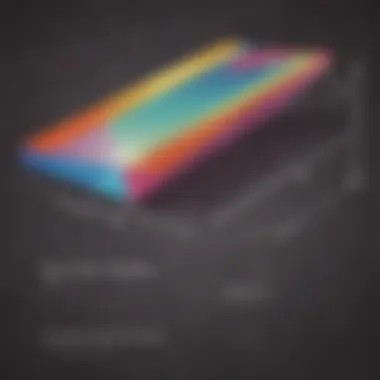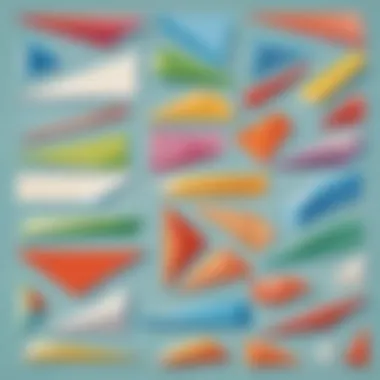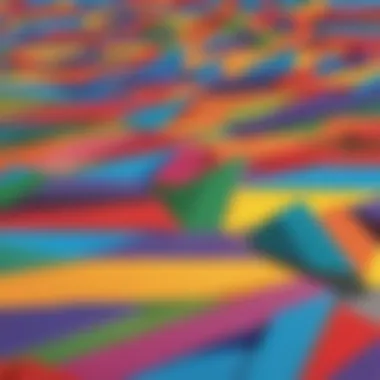Understanding the Properties of Parallelograms


Intro
In geometry, parallelograms hold a special place due to their distinct properties. Understanding these characteristics is vital, especially for young learners who are beginning their exploration of shapes and forms. This guide will unpack the essential traits of parallelograms, the various types that exist, and their real-world applications.
Learning about parallelograms contributes to a broader understanding of geometry. It helps students recognize the regularities and patterns found in shapes around them. By grasping the fundamental aspects of parallelograms, students will build a solid foundation for more complex geometrical concepts in the future. Let's dive into the world of parallelograms.
Prologue to Parallelograms
Parallelograms are more than just shapes on paper. They represent a fundamental concept in geometry that is essential for understanding how space and form interact. In this section, we aim to provide a solid foundation about parallelograms. We will explore the essential attributes that define them, delve into their historical context, and discuss their significance in the broader field of geometry.
Definition of Parallelograms
A parallelogram is a four-sided figure, or quadrilateral, characterized by having opposite sides that are both equal in length and parallel. This definition is crucial because it distinguishes parallelograms from other quadrilaterals that may have different properties. The key attributes include:
- Opposite sides are equal. This means that if you measure one side of a parallelogram, the side directly across from it will have the same length.
- Opposite sides are parallel. This establishes that the two sides will never meet, no matter how far they are extended.
Other specific types of parallelograms, such as rectangles, rhombuses, and squares, follow this definition while incorporating additional traits.
Historical Context
The study of parallelograms dates back to ancient civilizations. Mathematicians from ancient Greece, such as Euclid, recognized the importance of these shapes in understanding geometry. The term "parallelogram" itself originates from Greek words meaning "parallel lines." Over centuries, various cultures have explored geometric principles that include parallelograms, applying them in areas such as art, architecture, and even navigation. The evolution of mathematical thought has solidified the study of parallelograms as a key aspect of geometry, influencing modern mathematics.
Importance in Geometry
Parallelograms play a vital role in the understanding of geometric principles. They offer insights into more complex shapes and figures, making them a staple in geometry education. Here are a few points that highlight their significance:
- Foundation for Learning: Understanding parallelograms simplifies the learning of other geometric figures, such as trapezoids and triangles.
- Real-World Applications: They appear in architecture, engineering, and art, showcasing both functionality and aesthetic value.
- Geometric Proofs: Parallelograms serve as examples in geometric proofs, helping students grasp logical reasoning in mathematics.
"Parallelograms are not just theoretical constructs; they bridge the gap between basic geometry and practical application."
In summary, parallelograms are fundamental in both educational contexts and real-life applications. Their properties and historical significance provide a lens through which to explore the beauty and complexity of geometry.
Characteristics of Parallelograms
Characteristics of parallelograms form the basis for understanding how these shapes function within geometry. Knowing these traits aids in recognizing their relevance in geometric proofs and practical applications. Key traits include the properties of opposite sides, angles, and diagonals. Each characteristic is not just a fact, but it serves to build a deeper understanding of the shape's structure and significance.
Opposite Sides
Equal Length
The equal length of opposite sides is a crucial aspect of parallelograms. This characteristic ensures that in a parallelogram, the lengths of two opposite sides are always the same. This equality is significant because it establishes a foundational understanding of the shape's geometry. It illustrates symmetry and balance, making it easier to solve geometric problems involving these figures.
The trait of equal length can lead to predictable outcomes and simplifications when calculating perimeter and area. For instance, if one knows the length of one side, they can quickly find the other. This can be especially helpful in an educational context, aiding elementary school students in grasping basic geometric principles effectively. However, while this feature simplifies certain calculations, it may also lead to oversights if one assumes all four sides have equal lengths, as in a square.
Parallelism
Parallelism is another defining feature of parallelograms. It posits that opposite sides not only are equal in length but also run parallel to each other. This quality is essential in distinguishing parallelograms from other shapes such as rectangles and rhombuses. Understanding parallelism enhances reasoning about the properties of angles and areas within the shape.
For educational purposes, parallelism can be illustrated through drawing. The consistent distance between the lines helps students visualize and conceptualize the underlying geometric principles. Yet, a misunderstanding of parallel lines may lead to challenges in solving problems involving angles and intersecting lines in a broader context.
Opposite Angles
Congruence
Congruence of opposite angles is a critical point when discussing parallelograms. In this context, opposite angles share the same measure, which has implications for both theoretical and practical applications in geometry. Congruent angles help students explore relationships between various angles in polygons. This makes it easier to solve various problems, including those involving angle measurements and geometric constructions.
The concept may not appear complex but can create confusion in applications where other shapes are involved. Knowing that opposite angles are congruent aids learners in validating their results when proving properties of complex figures, making it an invaluable aspect of parallelogram study.
Supplementary Angles
Opposite angles in a parallelogram are not just congruent but also supplementary. This means that the sum of the measures of adjacent angles equals 180 degrees. This aspect is essential when engaging in proof-based geometry. Understanding why angles are supplementary allows students to solve problems through reasoning and calculation effectively.
This aspect enables broader applications, as these angles can assist in constructing various geometric shapes. However, students might find it challenging to remember this property, especially when faced with more complex figures that might have different angle relationships.
Diagonals


Bisecting Properties
The diagonals of a parallelogram exhibit unique bisecting properties. When drawn, the diagonals intersect each other at their midpoints. This symmetry indicates that each diagonal divides the parallelogram into two congruent triangles. This trait is particularly useful when engaging in area calculations or proving congruence in geometric proofs.
Understanding this property is beneficial for students learning about triangles and their relationships within quadrilaterals. However, learners can face confusion when they assume all diagonals in different shapes have the same properties.
Length Comparisons
Finally, the length comparisons of diagonals in a parallelogram also play a significant role. While the diagonals may not always be equal in length, their relationship provides great insight into the shape itself. In rectangles, for instance, diagonals are equal, while in rhombuses, the diagonals are of different lengths and intersect at right angles. These details enhance understanding but may challenge students trying to apply these concepts across various shapes.
The different lengths of the diagonals can affect problems relating to both area and perimeter. Elementary learners should grasp these relationships to apply their knowledge effectively.
Understanding these properties of parallelograms not only equips students with the knowledge to solve problems but also fosters a deeper appreciation for the beauty and organization of geometry.
Overall, the characteristics of parallelograms are vital. They not only lay the groundwork for understanding more complex geometric concepts but also enhance students' ability to reason logically in both academic and real-world contexts.
Types of Parallelograms
Understanding the various types of parallelograms is crucial for grasping the broader properties of these geometric shapes. Each type carries distinct characteristics that offer unique benefits and considerations. This section will focus on rectangles, rhombuses, and squares — three key categories of parallelograms. Knowing their properties can deepen one's appreciation of geometry and its practical applications.
Rectangles
Definition
A rectangle is defined as a parallelogram with four right angles. This characteristic makes rectangles recognizable and widely understood. Their simplicity in design is one reason they are so prevalent in both mathematics and real-world situations. A significant aspect of the rectangle is that opposite sides are equal in length. This uniformity lends itself to easy calculations, making rectangles popular for educational purposes.
Properties
The properties of rectangles contribute significantly to their importance in geometry. Each angle measures 90 degrees. This consistent angular measurement allows for straightforward computations, like calculating area and perimeter. One unique feature of rectangles is that their diagonals are equal in length and bisect each other at right angles. This quality ensures precision in various applications, from architectural design to everyday objects, but it also limits the versatility of the shape compared to other parallelograms.
Rhombuses
Definition
A rhombus is a type of parallelogram where all sides are of equal length. This attribute grants it a unique aesthetic appeal and offers practical applications. Understanding rhombuses involves recognizing that, while they maintain parallel opposite sides, they do not necessarily have right angles. This distinction allows for unique forms and is instrumental in fields like art and design.
Properties
The properties of a rhombus include opposite angles being equal and adjacent angles being supplementary. This means that the sum of angles at any corner is 180 degrees. Moreover, the diagonals of a rhombus not only bisect each other but also are perpendicular, which is a vital point for construction and design scenarios. While the elegant symmetry of a rhombus is beneficial for creating visually appealing designs, its complexity can pose challenges in problem-solving contexts.
Squares
Definition
A square is a special type of parallelogram that combines the attributes of rectangles and rhombuses. It has four equal sides and four right angles. This dual property makes squares some of the easiest geometric shapes to work with. Its definition highlights its foundational role in both geometry and practical applications.
Properties
The properties of squares convey substantial meaning in geometry. All sides are equal, and all angles are right angles, creating a highly symmetrical shape. The diagonals, like those in rectangles and rhombuses, are equal in length and bisect each other at 90 degrees. Squares can be seen as a versatile option in design contexts, but their strict equalities can limit creativity in geometry. Understanding squares helps develop problem-solving strategies in varied mathematical situations.
Real-World Applications
Architecture
Use in Design
In architecture, parallelograms create visually appealing structures. Their slanted angles help form dynamic shapes without compromising stability. This design choice supports creativity while maintaining practical requirements. Buildings with parallelogram shapes often appear modern and engaging. A unique feature of this use is how it blends form with function seamlessly. It can be a beneficial choice, as these designs stand out, attract attention, and enhance functionality.
Structural Integrity
Structural integrity refers to how well a structure can support loads and resist deformation. Parallelograms contribute positively here. Their opposite sides being parallel means that forces are evenly distributed, reducing the chance of failure. This is a popular characteristic for buildings and bridges. However, while parallelogram structures are strong, improper design can still lead to weaknesses, especially under extreme conditions.
Art and Design
Patterns


In art, parallelograms help create patterns that are both intriguing and complex. Artists use them to form repetitive designs that catch the eye. Parallelograms can bring harmony and rhythm to a piece. Their defined angles allow for consistency in patterns, which make them a beneficial element in visual design. However, creating such patterns can become tedious without an understanding of geometry.
Symmetry
Symmetry is crucial in art. Parallelograms naturally exhibit symmetry due to their properties, allowing artists to create balanced compositions. This aspect is appealing and satisfies aesthetic senses. The unique feature of symmetry in parallelograms makes them a favored choice for various artworks. But, achieving perfect symmetry can require skill and precision, making it a challenging endeavor for some artists.
Engineering
Mechanics
In the field of engineering, parallelograms are essential for understanding mechanics. When analyzing forces in structures, engineers often use parallelogram laws to break down forces into manageable components. This application demonstrates the functional aspect of parallelograms in problem-solving. Engineers find them beneficial for calculations related to forces and movements. However, applying these properties requires a solid grasp of both geometry and physics, which might be a barrier for some learners.
Material Properties
Material properties define how materials behave under various conditions. With parallelograms, engineers assess how materials respond to stress and strain. They apply these properties to ensure that their designs can withstand real-world forces. The key characteristic here is predictability, as understanding these relationships helps avoid potential failures. Yet, experimenting with material properties can involve complex tests, which adds a layer of difficulty.
Understanding how parallelograms function in real life provides a concrete context for their study, making geometric concepts more relevant and easier to grasp.
By highlighting these applications, it becomes clear that parallelograms are not merely academic topics. They are integral to our built environment and artistic expressions, as well as engineering principles.
The Role of Parallelograms in Geometry
Parallelograms hold a significant place in geometry, serving as a foundation for various mathematical concepts and proofs. Their unique properties allow for a deeper understanding of geometric relationships. This section outlines the multifaceted roles of parallelograms, particularly their applications in geometric proofs, coordinate geometry, and transformations.
Geometric Proofs
Using Properties
Using properties of parallelograms in geometric proofs is essential. The unique characteristics of these shapes enable students and mathematicians to establish relationships among angles, sides, and diagonals. One key aspect of this is that opposite sides are equal in length and parallel. This property simplifies many proofs, making it a preferred choice for students to learn the fundamentals of logical reasoning in geometry.
The significant advantage of using parallelogram properties is their ability to easily derive other geometric facts. For example, by demonstrating that opposite angles are equal due to the properties of parallel lines, students can develop a stronger understanding of the interconnections in geometry. However, a potential drawback is that students might overlook other essential properties of different shapes if they focus too much on parallelograms.
Logical Reasoning
Logical reasoning is a crucial component when working with parallelograms. This aspect involves utilizing known properties to arrive at valid conclusions. For instance, recognizing that the sum of the interior angles of a parallelogram equals 360 degrees helps students solve complex problems more effectively. Logical reasoning provides clarity and structure, making it a popular choice for constructing geometric arguments.
One unique feature of logical reasoning is that it encourages critical thinking. Students are challenged to justify their conclusions and develop more analytical skills. However, relying heavily on logical reasoning without proper visualization can sometimes lead to confusion for beginners. A balance of both is necessary for mastery.
Coordinate Geometry
Graphing Parallelograms
Graphing parallelograms utilizes coordinates to illustrate their properties visually. This practice allows students to understand how to position these shapes on a plane accurately. A significant characteristic of graphing parallelograms is its enhancement of spatial awareness. Students learn how to plot points, thereby improving their overall geometry skills.
The ability to graph parallelograms can simplify complex mathematical concepts. By visualizing shapes, students can better grasp how angles and sides interact. However, it is crucial to ensure that students do not become reliant solely on graphs, as this may hinder their ability to work with abstract geometric concepts.
Distance Formula
Using the distance formula as a tool in this context is beneficial because it supports a deeper understanding of geometry. However, it may present challenges for students who struggle with algebra, as it requires a solid grasp of equations and coordinates.
Transformations
Reflections
Reflections in geometry allow for a visual interpretation of parallelograms' properties. When a parallelogram is reflected across a line, its shape and dimensions remain unchanged, showcasing its symmetry. This aspect is particularly beneficial, as it helps students understand the nature of geometric transformations clearly.
The unique feature of reflections is that they reinforce the idea of congruence among shapes. This knowledge is foundational for constructing more complex geometric concepts. However, students may find it challenging to visualize until they get enough practice with hands-on activities.
Rotations
Rotations also demonstrate the properties of parallelograms effectively. When a parallelogram is rotated around a point, its properties remain intact. Understanding this concept is crucial as it highlights the role of rotational symmetry. This key characteristic helps students appreciate the invariant properties of shapes throughout various transformations.
The advantage of incorporating rotations into learning is its ability to deepen the understanding of geometric relationships. However, some students may struggle with grasping the direction and degree of rotation needed for accurate transformations. A methodical approach is beneficial in these cases.
Parallelograms are not just shapes; they are fundamental to understanding broader concepts in geometry, making their study essential for students.


In summary, parallelograms play a pivotal role in geometry by providing essential properties for proofs, offering methods for visualization through graphing and transformations, and enabling logical reasoning among students. These elements collectively contribute to a comprehensive understanding of geometric principles.
Challenges in Understanding Parallelograms
Understanding parallelograms involves navigating common pitfalls and misconceptions, which can hinder elementary students' grasp of the topic. This section addresses these challenges effectively. By acknowledging and clarifying these issues, learners can build a solid foundation in geometry. Clarity in understanding parallelograms not only assists in academic pursuits but also enhances appreciation for geometry in real-life scenarios.
Common Misconceptions
Identification Errors
Identification errors occur when students confuse parallelograms with other quadrilaterals. Parallelograms have specific features, such as opposite sides being equal and parallel. However, many learners may misidentify a rhombus or rectangle as a parallelogram without recognizing unique traits. This leads to confusion in solving geometrical problems.
The key characteristic here is recognizing those defining traits of a parallelogram. Understanding differences among quadrilaterals fosters better geometric comprehension. Yet, students might overlook these nuances, which can create inaccuracies in assessments.
Therefore, addressing identification errors is essential for developing accurate geometric reasoning and boosting confidence in math skills.
Angle Misunderstandings
Angle misunderstandings often stem from confusion surrounding the relationship between angles in parallelograms. In a parallelogram, opposite angles are equal, and adjacent angles are supplementary. Students sometimes struggle with this concept, leading to errors in calculations.
The principal aspect of angle misunderstandings lies in grasping these relationships. Clarifying how the angles interact significantly benefits students' overall understanding of parallel lines and bisectors in geometry. Misconceptions in this area can cause frustration when tackling angle-related problems, making clear instruction and practice necessary for overcoming this hurdle.
Complexity in Problem Solving
Solving for Side Lengths
Solving for side lengths in parallelograms challenges students, especially when coordinates are involved. It requires a firm grasp of geometric properties and application of formulas. Many learners may find it daunting to determine side lengths when provided with minimal information.
The key characteristic of solving for side lengths relates to understanding the properties of parallel sides. Applying these properties is beneficial for solving related problems correctly. However, the complexity frequently arises from a lack of solid foundation. A comprehensive approach, emphasizing practice and systematic reasoning, can foster accuracy in student calculations and problem-solving abilities.
Area Calculations
Calculating the area of a parallelogram demands both understanding the base-height relationship and applying the appropriate formula. The area is determined by multiplying the base length by the height. Students often make mistakes by using oblique measures instead of the perpendicular height. This error can significantly affect their results.
The essence of area calculations lies in ensuring students comprehend how height relates to the base. Providing clear examples and hands-on exercises facilitates mastery of this skill. Although challenging, grasping area calculations is crucial for success in broader mathematics and geometry concepts.
Resources for Further Learning
Understanding parallelograms goes beyond just recognizing their properties. It is valuable to utilize resources that can amplify learning and comprehension. Various tools, literature, and videos can offer learners deeper insights. They provide practical applications of the concepts and help integrate knowledge effectively into everyday life. These materials can bridge gaps and support both students and educators in grasping the significance of parallelograms in geometry.
Interactive Tools
Web-Based Programs
Web-based programs serve as an accessible platform for students to explore the properties of parallelograms interactively. These programs often feature user-friendly interfaces and engaging content. One key characteristic is their ability to allow users to visualize parallelograms in action. Learners can manipulate shapes in real-time, enhancing understanding of concepts such as parallelism and angle congruence.
The unique feature of these programs is their interactivity. Users can adjust the dimensions and angles of the parallelogram, observing the effects immediately. This hands-on approach can be beneficial for dynamic learning. However, a disadvantage may include the need for a stable internet connection, which might not always be available.
Math Apps
Math apps are designed specifically for mobile devices, making learning on-the-go possible. They often incorporate gamified elements, encouraging motivation and engagement. A significant advantage of Math apps is their convenience and portability. Students can use them anytime and anywhere to practice problems related to parallelograms.
A standout feature of many Math apps is their progress tracking. This allows learners to see their advancements over time. However, some apps may lack depth, providing only surface-level lessons without deeper exploration of concepts.
Books and Literature
Recommended Readings
Books provide a structured approach for learning about parallelograms. Recommended readings often include comprehensive explanations of both theory and practical exercises. A significant aspect is that they can be used as reference materials for learners of all levels. For example, works catered to elementary school students often simplify complex concepts, making them more approachable.
The unique feature of these readings is the inclusion of illustrations and practical examples. These elements appeal to visual learners. On the downside, some students may find physical books less engaging compared to digital media.
Textbooks
Textbooks are crucial for a thorough understanding of geometry, including shapes like parallelograms. They typically present information in a systematic manner, making them ideal for formal education settings. A notable characteristic of textbooks is their organization, often including problems and solutions that reinforce learning.
Furthermore, textbooks can serve as a comprehensive guide for both students and teachers. However, they may lack flexibility in content presentation, making them less adaptable than interactive tools or Math apps.
Educational Videos
Tutorials
Tutorials are an excellent resource for learners, providing visual guidance on how to tackle problems involving parallelograms. They are often concise and to the point, which helps maintain focus. A key characteristic is that many tutorials allow for step-by-step learning, making complex problems more manageable.
The advantage is that learners can pause and replay sections, catering to their personal learning pace. However, not all video tutorials may be equally helpful or align with curricular standards, which can lead to confusion.
Lectures
Lectures offer in-depth discourse on the properties of parallelograms. They often feature qualified educators explaining key concepts in detail. This resource is valuable for auditory learners who benefit from listening to explanations. A notable aspect of lectures is their ability to provide historical context and connections between concepts.
A disadvantage may be that lectures can be lengthy, and maintaining attention throughout may be challenging. Additionally, access to high-quality lectures may be limited, depending on institutional resources.
By utilizing various resources, learners gain a well-rounded understanding of parallelograms, reinforcing their importance in the broader context of geometry.







